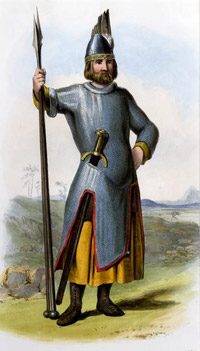WordPress database error: [Got error 28 from storage engine]
SELECT t.*, tt.*, tr.object_id FROM wp_terms AS t INNER JOIN wp_term_taxonomy AS tt ON tt.term_id = t.term_id INNER JOIN wp_term_relationships AS tr ON tr.term_taxonomy_id = tt.term_taxonomy_id WHERE tt.taxonomy IN ('category', 'post_tag', 'post_format') AND tr.object_id IN (3977, 4055, 50733) ORDER BY t.name ASC
Clan MacPhee (MacFie) History
The gaelic name Mac a’Phi gives the English phonetic spelling Macafie, sometimes shortened to Macfie or MacPhee. However, in its original form, the name was probable Mac Dhuibh Shith or “Son of the Dark Fairy”. The “dark fairy” is synonymous with the dark stranger who must be the first to cross the threshold at the turn of the new year, bringing presents of food and drink, and symbolising good fortune. Mac Dhuibh Shith is also anglicised to MacDuffie, another way of referring to the clan and in some early manuscripts both names are used to refer to the same person.
The identity of this stranger is mysterious but legend gives the family of MacPhee its descent from this supernatural creature, who was thought to come from the sea. So the descent of the MacPhees is shrouded in legend and traditional folklore.
The MacPhees of Colonsay were hereditary keepers of the records of the Lords of the Isles. Unfortunately these records have vanished almost without trace, with the exception of one medieval charter which remains extant. This charter is written in gaelic, which shows that the administration of the Lordship was carried out both in Latin and in the vernacular.
The MacFies fought alongside Robert the Bruce at Bannockburn in 1314.
After the abolition of the Lordship of the Isles, the MacPhees remained loyal to the MacDonald clan, and shared in the downfall of the powerful MacDonalds when the MacPhee chief was tricked, with other clan chiefs, into signing the infamous Statutes of Iona. When Colonsay passed into other hands.
As Supporters of Clan Donald the clan were frequently involved in clashes with the MacLeans of Duart. Malcolm, the last chief of the clan, supported an uprising led by sir James Macdonald which ultimately led to Malcolm murder in 1623 by Kitto MacDonald.
The clan became so completely rootless that today the name MacPhee is equated with the profession of itinerant tin-smiths known as “tinkers”. Many of the MacPhee clansmen settled in the Cameron country of the mainland, while others resettled on other islands. Lochaber then became the clan heartland.
MacFie pipers were present when Bonny Prince Charlie arrived at Glenfinnan in 1745 and MacFie’s fought on the right flank of the Jacobite army at Culloden. Many of the fallen clansmen are buried with their Cameron allies.
Following the worldwide rallying of Clan Mcfie members by Dr. Earle Douglas MacPhee of Vancouver, BC, Canada, the Lord Lyon King of Arms recognized the Clan on May 27th, 1981 as being once again, an active clan. In 1993, Clan Macfie met in Parliament on the island of Colonsay for the first time in 370 years. Some property was donated by the Lord Strathcona, present owner of the island, to erect the Standing Stone as a memorial to Malcolm Macfie the last clan chief. An ad hoc derbhfine was convened to select a suitable candidate for appointment to that position. In the autumn of 2008 the Lord Lyon appointed Iain Morris McFie as Commander or Ceann-Cath of Clan Macfie.
Clan MacPhee Posts










